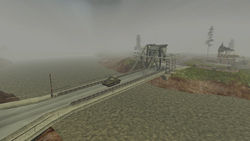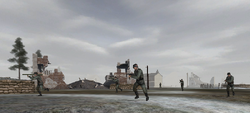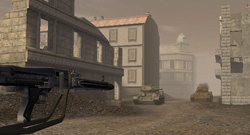No edit summary |
No edit summary |
||
| Line 135: | Line 135: | ||
====[[Iwo Jima]]==== |
====[[Iwo Jima]]==== |
||
| − | |||
| − | |||
| − | |||
{{Wars/BF}} |
{{Wars/BF}} |
||
| + | [[ru:Вторая мировая война]] |
||
[[Category:Wars]] |
[[Category:Wars]] |
||
[[Category:Battlefield 1942]] |
[[Category:Battlefield 1942]] |
||
Revision as of 19:46, 17 February 2012
World War II (often abbreviated to WWII or WW2. Also known as the Second World War, or on Eastern Front as the Great Patriotic War) was a global conflict lasting from 1939 to 1945, involving most of the world's nations including all of the great powers, eventually forming two opposing military alliances, the Allies and the Axis. It was the most widespread war in history, with more than 100 million military personnel mobilised. In a state of "total war," the major participants placed their entire economic, industrial, and scientific capabilities at the service of the war effort, erasing the distinction between civilian and military resources. Marked by significant events involving the mass death of civilians, including the Holocaust and the only use of nuclear weapons in warfare, it was the deadliest conflict in human history, resulting in 50 million to over 70 million fatalities.
Background
Since World War I, Germany was left in ruins. Within the early 1930s, Adolf Hitler became the chancellor (later furher) of the central European country. For Italy in the 1920s, Benito Mussolini rosed to power. In 1931, Japan used its army to invade northern China and by 1937, the whole of the eastern Asian mainland. By 1938, the Germans invaded half of the Czech Republic and Austria after Italian forces took Ethiopia in 1935. Ingoring a peace-time conference back in Munich of Germany, Hitler gradually took all of the Czech Republicans a year after. With new weapons tested since the Spanish Civil war in 1936-1939, Hitler's next target was Poland.
In order to take half of the country, he presuaded Joseph Stalin of the Soviets to secure a treaty which the Red Army will take the other half of Poland. On September 1st 1939, Germany invades Poland with a strong weapon known as blitzkrieg. Two days later, the British and French governments declared war on the Germans which caused a retreat from France a year later.
European Theatre
Italian Campaign
The Italian Campaign appears in Battlefield 1942: The Road to Rome. Northern Italy was a battleground in World War I, but by the Second World War was that Italy had to defend its homeland after Hitler's Afrika Krops were destroyed in Tunisia on May 13th of 1943. On the 9th of July, Operation Husky commenced to which the Allies consisting Anglo-Americans took on the Royal Italian Army for a month and thirty-nine days.
Operation Husky
9 July – 17 August 1943
Operation Baytown
3 September — 9 September 1943
Battle for Salerno
9 September 1943
Battle for Monte Cassino
17 January 1944 – 18 May 1944
Battle for Anzio
January 22, 1944 – June 5, 1944
Western Front
The Western Front of World War II was generally restricted to the same geographic regions as during World War I. During the war the front moved much further, as far west as the English Channel and as far east as the line which would become the Iron Curtain during the Cold War. Although fighting took place in Norway and Italy these are not usually included as part of the Western Front but as separate campaigns.
Battle of Britain
July 10 – October 31, 1940
The Battle of Britain was an air campaign waged by the Luftwaffe against the United Kingdom during the summer and autumn of 1940. The objective of the campaign was to gain air superiority over the Royal Air Force, especially Fighter Command. The name derives from a famous speech delivered by Prime Minister Winston Churchill in the House of Commons: "...the Battle of France is over. I expect that the Battle of Britain is about to begin."
The Invasion of Normandy
June 6 – August 25, 1944
Omaha Beach
June 6, 1944
Omaha Beach is the code name for one of the five sectors of the Allied invasion of German-occupied France in the Normandy landings on 6 June 1944. The beach is located on the coast of Normandy, France, facing the English Channel, and is 5 miles (8 km) long, from east of Sainte-Honorine-des-Pertes to west of Vierville-sur-Mer on the right bank of the Douve River estuary. Landings here were necessary in order to link up the British landings to the east at Gold Beach with the American landing to the west at Utah Beach, thus providing a continuous lodgement on the Normandy coast of the Bay of the Seine. Taking Omaha was to be the responsibility of United States Army troops, with sea transport provided by the United States Navy and elements of the Royal Navy.
Liberation of Caen
June 6 – August 6, 1944

A Candian Sherman tank crosses Pegasus Bridge during the Battle for Caen.
The Battle for Caen took place from June–August 1944 and was a battle between Allied forces primarily consisting of British and Canadian troops and German forces during the Invasion of Normandy.
Battle of Villers-Bocage
June 13, 1944
The Battle of Villers-Bocage took place during June 13, 1944, one week after the Allies landed in Normandy to begin the liberation of German-occupied France. The battle was the result of a British attempt to improve their position by exploiting a temporary vulnerability in the German defences to the west of the city of Caen. After one day of fighting in and around the small town of Villers-Bocage and a second defending a position outside the town, the British force retired largely intact.
Operation Market Garden
17 – 25 September 1944
Operation Market Garden was an Allied military operation, fought in the Netherlands and Germany in the Second World War. It was the largest airborne operation up to that time.
Battle of Remagen
7–25 March 1945
The Battle of Remagen was a battle between the forces of the United States of America and Nazi Germany in and around the German town of Remagen, particularly centred on the Ludendorff Bridge, the short-term reason why the Americans were fighting the Germans in Remagen.
Battle of the Bulge
December 16, 1944 – January 25, 1945

Wehrmacht infantry during the Battle of the Bulge.
The Battle of the Bulge was a major German offensive, launched toward the end of the war through the densely forested Ardennes mountain region of Wallonia in Belgium, hence its French name, Bataille des Ardennes, and France and Luxembourg on the Western Front. The Wehrmacht's code name for the offensive was Unternehmen Wacht am Rhein ("Operation Watch on the Rhine"), after the German patriotic hymn Die Wacht am Rhein. This German offensive was officially named the Ardennes-Alsace campaign by the U.S. Army, but it is known to the English-speaking general public simply as the Battle of the Bulge, the "bulge" being the initial incursion the Germans put into the Allies' line of advance, as seen in maps presented in contemporary newspapers.
Eastern Front
Before 1917, a city in Europe's eastern direction was part of heavy Soviet forces fighting the Germans. Twenty-one years later, Hitler plans an invasion of the Soviet Union. On the first day of October, Germany was encountered by the Soviets at Kharkov trying to get hold of three major outposts in the ruined city. As the battle dreadfully continues, Stalingrad and Kursk became heavily bombarded by German artillery. On the same day of August 23rd, 1943 was that the Soviets had won the two battles against the Germans.
Battle of Kharkov
October 1, 1941 - August 23, 1943
Four operations in Kharkov, Ukrainian SSR.
Battle of Stalingrad
August 23, 1942 - February 2, 1943
The Battle of Stalingrad was a major battle in the war in which Nazi Germany and its allies fought the Soviet Union for control of the city of Stalingrad (now Volgograd) in southwestern Russia. The battle took place between August 23, 1942 and February 2, 1943. It was among the largest on the Eastern Front and was marked by its brutality and disregard for military and civilian casualties. It was amongst the bloodiest battles in the history of warfare with the higher estimates of combined casualties amounting to nearly two million. In its defeat, the crippling losses suffered by Germany's military proved to be insurmountable for the war. The battle was a turning point in the war after which the German forces attained no further strategic victories in the East.
Battle of Kursk
5 July - 23 August 1943
The Battle of Kursk took place when German and Soviet forces confronted each other in the vicinity of the city of Kursk, in the Soviet Union in July and August 1943. It remains both the largest series of armored clashes, including the Battle of Prokhorovka, and the costliest single day of aerial warfare in history. It was the final strategic offensive the Germans were able to mount in the east. The resulting decisive Soviet victory gave the Red Army the strategic initiative for the rest of the war.
The Battle of Berlin
April 16, 1945 – May 2, 1945

Soviet T-34s during the Battle of Berlin.
The Battle of Berlin, designated the Berlin Strategic Offensive Operation by the Soviet Union, was the final major offensive of the European Theatre of World War II, resulting in the decimation of the German forces and the surrender of Germany. It was one of the bloodiest battles in history.
— German defeat at Berlin, signaling the end of the War in Europe
African Theatre
Western Desert Campaign
When Italy declared war on Britain and France in June 1940, the British pushed the Italians in Libya from invading Egypt to Tunisia, Morocco and Algeria. Germany helped out with the Afrika Korps to destroy the British forces. As the Germans drove down to Egypt, British and its Commonwealth soldiers holded off the Germans at Tobruk in a siege until June 1942 where the Germans finally captures the fort.
Siege of Tobruk
Operation Battleaxe
Battle of Gazala
Operation Aberdeen
Second Battle of El Alamein
Pacific Theatre
American forces took part in defending Wake Island after the Japanese victory at Pearl Harbor. The battle rages on Midway Island, the Philippines, Guadalcanal and Iwo Jima. The Coral Sea was another battle as part of the Pacific theatre. Japan fights off the Americans as they control all islands and coral reefs from being captured.
Wake Island
Invasion of the Philippines
Battle of Midway
Coral Sea
Iwo Jima
| |||||
